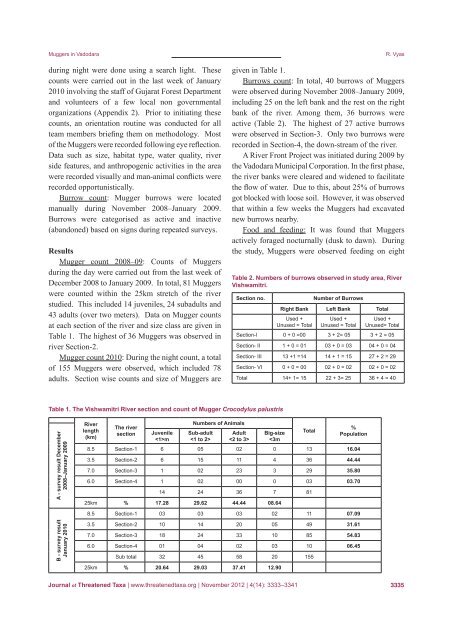View - Journal of Threatened Taxa
View - Journal of Threatened Taxa
View - Journal of Threatened Taxa
Create successful ePaper yourself
Turn your PDF publications into a flip-book with our unique Google optimized e-Paper software.
Muggers in Vadodaraduring night were done using a search light. Thesecounts were carried out in the last week <strong>of</strong> January2010 involving the staff <strong>of</strong> Gujarat Forest Departmentand volunteers <strong>of</strong> a few local non governmentalorganizations (Appendix 2). Prior to initiating thesecounts, an orientation routine was conducted for allteam members briefing them on methodology. Most<strong>of</strong> the Muggers were recorded following eye reflection.Data such as size, habitat type, water quality, riverside features, and anthropogenic activities in the areawere recorded visually and man-animal conflicts wererecorded opportunistically.Burrow count: Mugger burrows were locatedmanually during November 2008–January 2009.Burrows were categorised as active and inactive(abandoned) based on signs during repeated surveys.ResultsMugger count 2008–09: Counts <strong>of</strong> Muggersduring the day were carried out from the last week <strong>of</strong>December 2008 to January 2009. In total, 81 Muggerswere counted within the 25km stretch <strong>of</strong> the riverstudied. This included 14 juveniles, 24 subadults and43 adults (over two meters). Data on Mugger countsat each section <strong>of</strong> the river and size class are given inTable 1. The highest <strong>of</strong> 36 Muggers was observed inriver Section-2.Mugger count 2010: During the night count, a total<strong>of</strong> 155 Muggers were observed, which included 78adults. Section wise counts and size <strong>of</strong> Muggers areR. Vyasgiven in Table 1.Burrows count: In total, 40 burrows <strong>of</strong> Muggerswere observed during November 2008–January 2009,including 25 on the left bank and the rest on the rightbank <strong>of</strong> the river. Among them, 36 burrows wereactive (Table 2). The highest <strong>of</strong> 27 active burrowswere observed in Section-3. Only two burrows wererecorded in Section-4, the down-stream <strong>of</strong> the river.A River Front Project was initiated during 2009 bythe Vadodara Municipal Corporation. In the first phase,the river banks were cleared and widened to facilitatethe flow <strong>of</strong> water. Due to this, about 25% <strong>of</strong> burrowsgot blocked with loose soil. However, it was observedthat within a few weeks the Muggers had excavatednew burrows nearby.Food and feeding: It was found that Muggersactively foraged nocturnally (dusk to dawn). Duringthe study, Muggers were observed feeding on eightTable 2. Numbers <strong>of</strong> burrows observed in study area, RiverVishwamitri.Section no.Number <strong>of</strong> BurrowsRight Bank Left Bank TotalUsed +Unused = TotalUsed +Unused = TotalUsed +Unused= TotalSection-I 0 + 0 =00 3 + 2= 05 3 + 2 = 05Section- II 1 + 0 = 01 03 + 0 = 03 04 + 0 = 04Section- III 13 +1 =14 14 + 1 = 15 27 + 2 = 29Section- VI 0 + 0 = 00 02 + 0 = 02 02 + 0 = 02Total 14+ 1= 15 22 + 3= 25 36 + 4 = 40Table 1. The Vishwamitri River section and count <strong>of</strong> Mugger Crocodylus palustrisA - survey result December2008–January 2009Riverlength(km)The riversectionJuvenilemNumbers <strong>of</strong> AnimalsSub-adultAdultBig-size

















